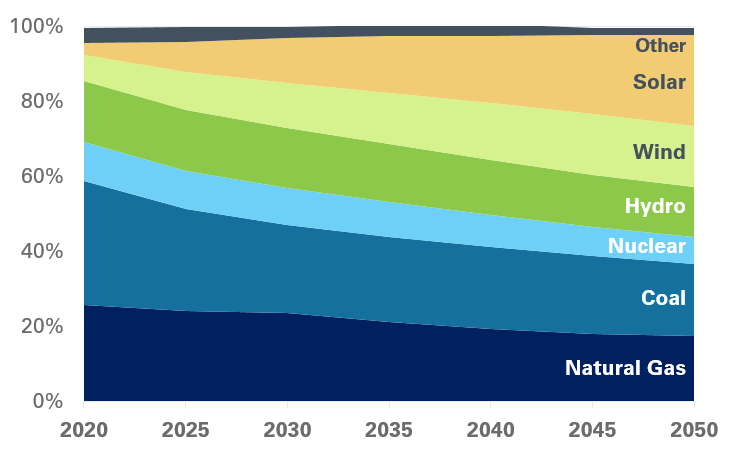What does it mean to invest in energy today? Two decades ago, the answer was a straightforward one. Energy meant oil and gas and a host of supportive industries, and it was represented as a large chunk of the S&P 500 as technology did. Today, energy has shrunk to about 5% of the S&P 500, and traditional oil and gas companies are facing challenges, including a range of alternative and renewable technologies. For large-scale investors like endowments and foundations, investing in energy demands a whole new approach.
Two Steps Forward, One Step Back
The energy sector has undergone significant changes in recent years due to advancements in technology, shifts in consumer behavior, and government regulations. The rise of renewable energy sources, such as wind and solar power, has led to a decrease in the forecasted demand for traditional fossil fuels. In addition, the shift towards energy efficiency and conservation has dampened overall growth in energy consumption. This has resulted in lower profits for traditional energy companies, and some have been forced to diversify their portfolios or risk becoming obsolete. While the transition from oil and gas to greener forms of energy feels like a meaningful long-term investment opportunity, the switch has been complex, time-consuming and expensive.
The changes in the energy sector have been particularly perplexing because they haven’t been smooth, and performance has been highly unpredictable. For example, rising interest rates and ongoing supply chain challenges created significant commodity price volatility between 2020 and 2022, wreaking havoc on price-sensitive energy investments. Although the transition to green and renewable energy sources has gained momentum over the past decade, oil and gas has dramatically outperformed in the past year, dulling investors’ enthusiasm for more sustainable options.
The extreme volatility of the past three years has also turned off some large-scale investors. University endowments and foundations, especially, are grappling with how to navigate this space. Investors are concerned about the upward pressure on energy prices (and performance) while balancing the long-term implications of energy investments. Understandably, clients are concerned about both the environment and the financial stability of these institutions; after all, investors won’t want to put money in the sector and not realize their target returns. While energy’s overall total performance has rebounded in the past year, endowments and foundations are reconsidering how they invest in the energy space as they simultaneously pursue returns and sustainability.
The Future is Starting to Take Shape
Unfortunately, clear-cut solutions on how to invest in the energy space are yet to present themselves. Pricing, volatility and supply-chain challenges will likely persist in the energy sector, at least in the near term. The transition to renewable energy has been a slow one, and we will continue to be reliant on fossil fuels for many more years. But the industry is changing in ways that are capturing the attention of forward-thinking investors.
For example, investment opportunities in sustainable energy products are becoming more common and attractive. Strategies with a focus on renewable energy are springing up across the risk and return spectrum, providing investors with more substantive options to add to their portfolios. Even among traditional energy strategies, managers are increasingly aware that we are on the cusp of a significant energy transition as they look toward the future. Traditional energy fund managers know their strategies need to evolve as part of this transition and that they can’t market themselves in the same way as they have in the past.
The shift to green and sustainable energy opens the door to new opportunities that are less speculative and have a longer-term horizon for investors. For example:
- As renewables become a larger portion of our energy consumption, the world needs upgraded power transmission and energy storage technology to provide stability and reduce residual waste as we move closer to “carbon-neutral” targets.
- Private infrastructure managers are broadening their range of investments to support new approaches to energy transmission and distribution. Beyond wind and solar power generation assets, they are also targeting improvements in electrical grids, infrastructure to support electric vehicles, battery storage facilities, and waste management. Acknowledging that traditional energy will continue to be a main source of power supply for some time, there are even strategies focused on reducing carbon emissions for extracting fossil fuels.
Opportunities in traditional energy will also still exist and continue to be a fundamental strategy for many investors, as the new energy infrastructure slowly sets up. Although oil and gas as an asset class is constantly evolving—from an investor and a regulatory standpoint—some companies are doing better than others in anticipating and adapting to changes. Pressure from investors has forced companies to focus on sustainable cash flow generation and more conservative balance sheets. Meanwhile, an increased focus on environmental standards has driven the sector to be more thoughtful around the environmental impact of extraction. Those investors who take environmental, social and governance (ESG) seriously have increased options to invest across traditional energy and emerging technologies.
Energy Sources Through 2050

New Ideas, New Strategies
This tussle between a traditional and forward-thinking approach to energy investing will certainly challenge endowment and foundation investors over the next few years, but it also creates a path for investors to manage their energy strategy.
How can endowments and foundations reduce the risk and pursue a stable return profile while maintaining a focus on sustainability? Our advice is to keep the phrase “future proofing” in mind as we navigate the transition. Traditional energy continues to be a vital power source globally, and the sector is improving after its downturn of the last few years. There is growing awareness and support for companies who are taking steps today to reduce their carbon footprint tomorrow. Still, many traditional energy companies will be seeking capital as the attention continues to shift to more ESG-friendly assets. We recommend endowments and foundations take a long-term approach to building an investing strategy, incorporating the best of traditional energy while investing in proven technologies designed to move us forward into the future of energy production.



